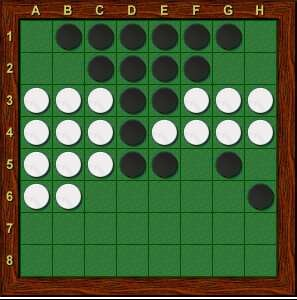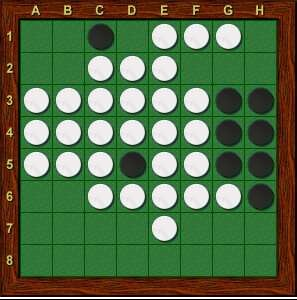- It’s all about mobility
- Tempo
As we’ve noticed in the previous sections, having and keeping mobility is a very important thing. When you run out of mobility it’s very likely that your opponent is going to force you to give up a corner and they will win. In the midgame, your job is usually to avoid running out of mobility while retaining a good position and trying to run your opponent out of mobility in return. Often, you will find that there are moves that you are forced to play or your opponent will run you out of mobility. Most of the time when I refer to a move as being a forced move, it means that the move must be played to prevent the other player from attaining a killer sequence. Obviously, if there is only one valid move on the board it is also a forced move. Let’s take a look at a position where one of the players has a forced move.

|
In that position, white is already way ahead on mobility but black isn’t dead just yet. While white is certainly winning he or she should still have to work to finish off the game if black plays accurately. However, black’s next move is forced. Black MUST play B1 here. If black doesn’t play B1 then white will take the edge with G1 next turn. To understand why, let’s take a look at what happens if black plays a different move.
|
| BLACK TO PLAY
|

|
If black plays H6 then white responds with G1. Black is then forced to play G6 next (as it’s the only legal move) to which white responds B1 and then black must play an X-square. If, in the original position, black takes the edge by playing B1, his position isn’t exactly desirable, but he survives a while longer and gives white the opportunity to make a mistake.
|
| BLACK PLAYS H6 – WHITE PLAYS G1
|

|
In the example, both players can take the north edge with a gain of tempo. We say that a player has gained a tempo when they play a move or a sequence of moves that gain them an additional safe move without giving their opponent any new safe moves. Additionally, after white has played to G1, B1 becomes a safe move for white and playing B1 doesn’t create any new safe moves for black. Thus white has gained two tempo via this sequence. Very often, the moves that are the most likely to be forced are moves that we have to play in order to prevent our opponent from gaining too many tempo. In fact, there are times when it is possible to win 3 or 4 tempo with proper play! Let’s take a look at an example.
|
| BLACK PLAYS G6 – WHITE PLAYS B1
|
| In this diagram, the move to C1 is the first tempo that is won in a sequence that wins 4 tempo for black! Even if white could somehow pass for the next 3 moves, black would still be in good shape. Let’s take a look at this fictional “game” where black plays the next 3 moves and uses up all of his or her spare tempo.
|

|

|
| BLACK TO PLAY
|
BLACK PLAYS C1
|

|

|

|
| BLACK PLAYS F1
|
BLACK PLAYS B1
|
BLACK PLAYS G1
|
Another common example of a forced move is when your opponent is threatening to take a corner and you have to play a certain move to prevent that from happening. Let’s look at an example:

|

|
In the left picture, while white has many possible moves, white is forced to play A6 even though this move flips a lot of black disks and almost eliminates black’s frontier. If white doesn’t take the edge, black wins the A1 corner and wins the game convincingly.
|
| WHITE TO PLAY
|
WHITE PLAYS A6
|
From the above examples, it’s easy to see that a lot of times we will be forced to take edges in order to prevent our opponent from gaining enough tempo to run us out of mobility or to prevent them from taking corners.
Often, when we’re looking for a killer sequence, we are looking for a way to win a single tempo because if we win a single tempo our opponent runs out of safe moves.

|
In the example, while white has no safe moves at the moment, every black move gives white more
safe moves to play. For instance, if black plays F7 then white can safely play to F8. In fact, if black
could pass here, he would win because white would be forced to give him the H1 corner. Fortunately,
black has a forcing sequence that wins a tempo which in many cases is the same as passing. If black
plays D1 then white will be forced to play B1 to protect the H1 corner. Black can then win the game
by playing F2 forcing white to lose the H1 corner.
|
| BLACK TO PLAY
|

|

|

|
| BLACK PLAYS D1
|
WHITE PLAYS B1 (FORCED)
|
BLACK PLAYS F2 AND WINS
|
Because Othello is a game where you often want to pass in order to improve your position , winning tempo from your opponent and not losing any tempo in return will often go a long way towards winning a game.
Exercises:
|
|
1.
|
2.
|
|
|

|

|
|
|
BLACK TO PLAY AND GAIN TEMPO
|
WHAT IS WHITE’S FORCED NEXT MOVE?
|
|
|
3.
|
4.
|
|
|

|

|
|
|
WHITE TO PLAY AND WIN
|
WHITE TO PLAY AND WIN
|
Answers:
| 1. Black plays G1.
2. White plays B1 (otherwise Black wins tempo with G1 and then B1).
|
3.
|
4.
|

|

|



















